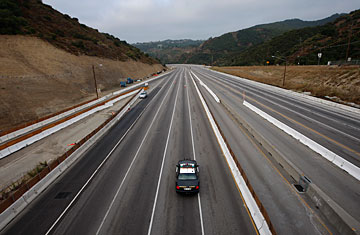
One of the busiest freeways in California, the 405, stands vacant as workers demolish the south side of Mulholland overpass on the freeway during the 53-hour total freeway closure resulting in massive traffic disruptions expected throughout the region on July 16, 2011 in Los Angeles, California.
"Traffic's moving like a breeze through Sepulveda Pass on the 405," came the announcement from Los Angeles radio station KPCC at 6 pm Friday evening. They were unfamiliar words to Angelenos, who endure painstaking delays on this stretch of freeway every day of the week — worst of all, Fridays — and who had been bracing for unprecedented gridlock this weekend as crews prepared to close the 10-mile stretch of freeway between Interstate 10 and US 101 in what the media has dubbed "Carmageddon."
Indeed, at Sepulveda Pass and other notoriously traffic-snarled spots like the east-bound I-10, Sunset Boulevard and Pacific Coast Highway, there was barely any traffic to be found Friday night and driving conditions were downright pleasant. "The past two months, LA traffic has been crazy, but today is strange," Jesse Mass, who lives on Sepulveda where the 405 meets the 101, told TIME while surveying a trickle of passing cars from a gas station on Sepulveda. "It doesn't look as scary as I thought it would."
David Quiros, a doctoral student who spent the day Friday sitting in a lawn chair next to the 405 surveying traffic and measuring air quality as part of a study by UCLA's School of Public Health of the 405 closure, said traffic was significantly lighter compared with what he saw during the same hours last Friday. "It seemed like a lot of businesses planned not to be working. There were fewer heavy- and light-duty diesel trucks on the road and it seemed like a lot of commuters weren't there either," Quiros says.
Officials say the failure of the much-hyped Carmageddon to materialize in the hours leading up to the freeway closure is because they got their message out effectively. Police Officer Sara Faden of the LAPD, who was stationed at the 405 on-ramp closest to the soon-to-be-demolished Mulholland Bridge during rush hour last night, noted that she herself commutes from the San Fernando Valley on this route and that traffic looked lighter than usual. "It means we've done a great job preparing people for the commute," Faden tells TIME.
For some Angelenos, the empty roadways were reminiscent of the 1984 Olympics, when officials warned of terrible traffic snafus. "What we saw in '84 was that people didn't go anywhere," says Larry Balarksy, a Los Angeles native who chose to tackle Carmageddon on his motorcyle. "I think it'll be closer to that this weekend."
If there's one thing Angelenos take seriously, it's traffic, and many businesses responded to Carmageddon warnings by giving employees permission to work from home or knock off early in the day to mitigate their drive times. Commuters like Terry Wilson, a product manager at NBC Universal who lives in Woodland Hills, took advantage of the opportunity to leave work early but also went an extra step to avoid getting stuck in Carmageddon traffic jams. Wilson, an avid cyclist, rode his bike home — a three-hour plus endeavor that took him over the Mulholland Bridge itself. Despite the lack of actual traffic, Wilson was pleased with his decision. "It's been a great ride," Wilson says. "The canyons are beautiful on either side and there's a nice breeze."
Still, many Angelenos remain concerned about the traffic prognosis for the weekend ahead. Pablo Cruz, owner of Bel-Air Auto Care, adjacent to the closed section of the 405, is anticipating a boom in business this weekend and will open his car repair shop on Sunday for the first time ever. "It's going to be jammed. There will be a lot of traffic coming through here," Cruz says, adding that he expects to help motorists with minor problems like flat tires or over-heating. "I won't do any big jobs because I won't be able to get any parts delivered."
For some residents of Bel Air, access to the rest of the city is seriously limited because Sepulveda and the 405 are the main arteries linking them to other neighborhoods, and Cruz says many of his customers left town for the weekend. Mass, who lives north of there in one of the areas where traffic is expected to be the worst, at the 405-101 interchange, is planning a staycation for himself and his family. "We've stocked up on movies and food and there's a park nearby where my son can play. I'm going to be one of those people who don't go anywhere."
Quinos, the doctoral student, predicts that confused motorists will create micro traffic jams near on-ramps they didn't know would be closed and he says 6pm Saturday, when traffic was at its worst last weekend, will be the real test of whether Carmageddon actually materializes or, like all doomsday predictions, turns out to be much ado about nothing.
